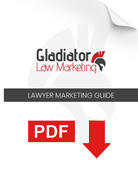

Lawyer Marketing Guide
The Impact of Google’s BERT Algorithm
on Law Firm Rankings
Explore how Google’s BERT algorithm update had a profound impact on law firm SEO.
Google’s BERT (Bidirectional Encoder Representations from Transformers) algorithm, which was introduced in 2019, was a major leap in search engine technology. BERT’s main aim is to understand the meaning of words in a search query so it can give more accurate search results. In this article, we’ll look at how Google’s BERT algorithm impacts how law firms rank in search results. We’ll also discuss what this means for law firms’ websites and how they can optimize them in light of this algorithm update.
Understanding Google’s BERT Algorithm and How It Affects Searches:
Getting Context Right:
One of the primary goals of the BERT algorithm is to better grasp the context of each word in a search query. Instead of just looking at individual words, BERT examines the whole search phrase. This in-depth understanding of language lets BERT provide search results that are more accurate and relevant.
Making Sense of Language:
BERT’s ability to understand natural language is what sets it apart. It can make sense of complicated search queries, including ones with prepositions, superlatives, or negations. This is especially important for law firms, as their target audience might use intricate legal terms when searching for services.
What It Means for Law Firm Rankings:
Focusing on Specific Keywords:
With BERT’s improved understanding of complete search phrases, it’s crucial for law firms to pay attention to what are called “long-tail keywords.” These keywords are more specific and generally have fewer people searching for them. By targeting long-tail keywords that match the legal services they offer, law firms can better meet the needs of potential clients and improve their rankings in relevant search queries.
Emphasize Content That Fits the Context:
In the age of BERT, it’s essential for law firms to prioritize creating content that directly addresses the specific needs and questions of their target audience. By producing valuable and informative content that aligns with the purpose of particular search queries, law firms can improve their search engine rankings and establish their expertise in their legal fields.
Tailor Content to User Needs:
Understanding what users are looking for is critical for law firms aiming to make the most of BERT’s algorithm. By analyzing the intentions behind various search queries, law firms can customize their content to meet the requirements of potential clients at various stages of their journey. This includes optimizing landing pages, blog posts, and FAQs to match the precise intention behind a user’s search.
Leverage Structured Information:
BERT also values structured data, like schema.org markup, to get a better grasp of the context and content of web pages. Law firms can enhance their websites by using structured data to offer specific information about their services, locations, reviews, and other pertinent details. This enables search engines to interpret and display this information more accurately in search results.
Google’s BERT algorithm has transformed the world of search engines by improving how they understand the context of search queries. For law firms, aligning their SEO strategies with BERT’s capabilities can lead to better search rankings and increased visibility among their desired audience. By optimizing content with long-tail keywords, focusing on user intent, creating contextually relevant content, and utilizing structured data, law firms can effectively navigate the impact of Google’s BERT algorithm and enhance their online presence.
Explore the central role website design plays in your law firm’s digital marketing.



